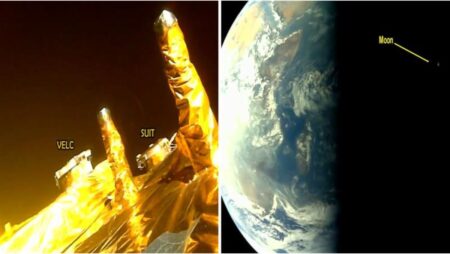ISRO has stated that the Chandrayaan 2 Large Area Soft X-ray Spectrometer (CLASS) has found a copious amount of sodium on the surface of the moon for the very first time.
Detailed work on the abundance of sodium discovered by the mission was published recently in The Astrophysical Journal Letters by the national space agency.

According to a statement issued by the National Space Research Agency, scientists at the Indian Space Research Center came to the conclusion that part of the signal from CLASS could be due to the presence of a thin veil of sodium atoms that are very faintly tangled with the lunar grains, the study says.
If these atoms were not an element of lunar minerals, then they could be easily shoved off of the moon’s surface by solar wind or ultraviolet radiation. Also, the diurnal variations of the surface sodium are responsible for the delivery of atoms to the exosphere, thus playing a major role in sustaining it.
The alkali element is present in the nebulous atmosphere of the moon, which is the thinnest area where atoms rarely meet. This specific region, titled as the exosphere, starts at the moon’s surface and continues for many thousands of kilometres, finally converging into interplanetary space.
According to ISRO, there is a constant variation in the atoms present on the surface of the moon every day.
Mission Chandrayaan: Pride of India
The ISRO said the new findings from Chandrayaan-2 provide an avenue to study surface-exosphere interaction on the moon, which would aid the development of similar models for Mercury and other airless bodies in our solar system and beyond.
Chandrayaan 2 was launched in 2019 to orbit around the moon. Ever since then, this was the first time it had made a path-breaking discovery.
With the help of new findings, scientists can explore more in the study of surface-exosphere interaction on the moon. It would also help in the development of identical models for Mercury as well as for the other planets in the solar system and beyond.
The Chandrayaan-2 Large Area Soft X-ray Spectrometer, or CLASS, was built at the UR Rao Satellite Center, which is a part of ISRO. It is embedded with features like high sensitivity and performance, which played a huge part in the recent discovery.
Based on the new results from Chandrayaan-2, the surface-exosphere interaction on the Moon can be studied to find out what else is in our sun and study the rest of the gasless matter.’
Chandrayaan-2 also made an early discovery of plasma density in the wake region of the moon’s ionosphere. The density in this present region is at least one order of magnitude more than that which is present on the day side.
Beginning with its launch in August 2019, this particular spacecraft has been studying the lunar surface very closely from its path of orbit. Many such findings have already been made earlier by Apollo, Luna, and China’s Chang’e mission. Records based on successive laboratory investigations of returned samples were already known to astronauts around the world.
This new discovery could lead to finding out how and why sodium gives the moon a faint glow similar to that of a sodium vapour lamp. Apparently, there are two types of sodium present on the lunar surface. One of them is bound to the loose grains in the moon crust and the other is found in the minerals of the moon.
Apart from these, India’s very own first lunar mission, Chandrayaan 1,’s X-ray Fluorescence Spectrometer (C1XS), also detected sodium with the help of its X-rays, which opened up the likelihood of sodium mapping on the moon. Chandrayaan 2 is India’s second unmanned mission to the moon after the success of Chandrayaan 1.













